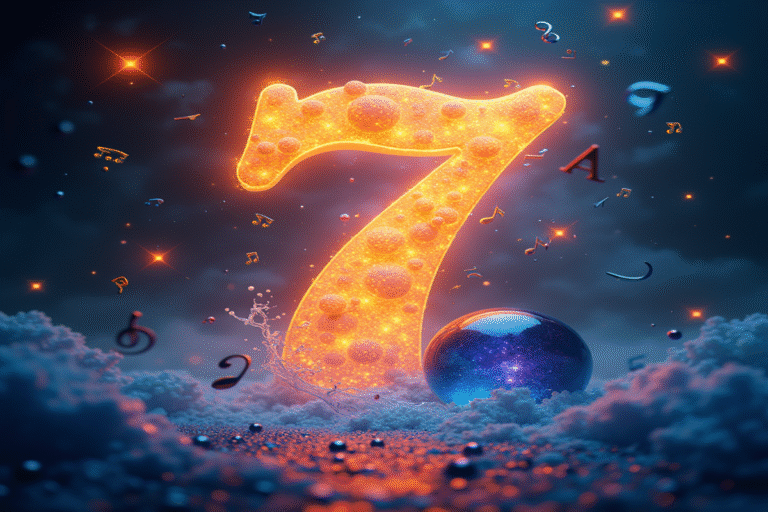Imagine looking at the number 7 and seeing it glow bright orange. Or hearing a cello play and watching deep blue waves ripple through your vision. Perhaps biting into a steak might make you feel a smooth, cool sphere in your hands. These extraordinary sensory experiences aren’t hallucinations—they’re real experiences of people with synesthesia, one of the most fascinating phenomena in human perception.
The Blended Senses of Synesthesia
Synesthesia, from Greek words meaning “together” and “sensation,” is a neurological trait where stimulation of one sensory pathway automatically triggers experiences in a second sensory pathway. Essentially, the senses become intertwined in ways most people never experience. About 4% of the population has some form of synesthesia, though many live their entire lives without realizing their perception differs from others.
“I always thought everyone saw days of the week in color,” explains Jamie, a grapheme-color synesthete. “Tuesday has always been emerald green to me. When I discovered others don’t see this, I was genuinely shocked.”
The Many Flavors of Crossed Senses
Researchers have documented over 80 different types of synesthesia. Some of the most common include:
- Grapheme-color synesthesia: Letters and numbers trigger specific color perceptions
- Chromesthesia: Sounds evoke colors or visual patterns
- Lexical-gustatory synesthesia: Words produce distinct taste sensations
- Time-space synesthesia: Time units (months, weekdays) are perceived as having specific spatial arrangements
- Mirror-touch synesthesia: Observing someone being touched triggers the sensation of being touched oneself
For James Wannerton, who has lexical-gustatory synesthesia, certain words provoke strong taste sensations that have influenced his entire life. The word “jail” tastes like cold, hard bacon, and “London” tastes like earwax. Such associations remain remarkably consistent throughout a synesthete’s lifetime.
The Neuroscience of Blended Senses
What’s happening in the synesthetic brain? Two leading theories explain this phenomenon:
The cross-activation theory suggests that synesthesia results from increased neural connections between brain regions that process different sensory information. In grapheme-color synesthesia, for instance, the brain areas processing letters and colors show heightened connectivity.
The disinhibited feedback theory proposes that all humans have connections between sensory areas, but most people have inhibitory mechanisms that prevent cross-talk. In synesthetes, this inhibition is reduced, allowing sensory “leakage” between brain regions.
Recent neuroimaging studies reveal that when synesthetes experience their crossed sensations, multiple brain regions activate simultaneously—regions that wouldn’t typically fire together in non-synesthetes.
Creativity and the Synesthetic Mind
Synesthesia appears disproportionately among artists, musicians, and writers. Famous synesthetes include:
- Painter Wassily Kandinsky, who painted the sounds he heard
- Musician Pharrell Williams, who sees colors when he hears music
- Author Vladimir Nabokov, who described his colored letters in his autobiography
- Physicist Richard Feynman, who saw equations in color
This connection to creativity isn’t coincidental. Research suggests that synesthesia may enhance memory, promote abstract thinking, and help make creative connections between ideas—all valuable assets for creative work.
Is Synesthesia Genetic?
Synesthesia runs in families, suggesting a genetic component. Studies indicate that about 40% of synesthetes have a first-degree relative with the condition. Scientists have identified several genetic regions associated with synesthesia, though no single “synesthesia gene” has been found.
Interestingly, synesthesia is more common in women (with a 6:1 ratio in some studies) and in left-handed individuals, further pointing to neurobiological factors.
Can You Develop Synesthesia?
While synesthesia typically appears in early childhood, certain circumstances can induce synesthesia-like experiences later in life:
- Acquired synesthesia: Following head injury, stroke, or blindness
- Drug-induced synesthesia: Psychedelic substances like LSD can temporarily produce synesthetic experiences
- Meditation-induced synesthesia: Deep meditative states sometimes trigger cross-sensory experiences
Some researchers have developed training programs to induce mild synesthetic associations in non-synesthetes, though these lack the automatic, involuntary quality of true synesthesia.
Testing for Synesthesia
How do scientists verify someone truly has synesthesia? The key is consistency. True synesthetes show remarkable consistency in their associations over time—if the letter “A” is crimson red today, it will be the same shade years later.
The Synesthesia Battery, an online test built by researchers, measures this consistency to distinguish genuine synesthesia from learned associations or imagination.
A Window Into Perception and Consciousness
Beyond its inherent fascination, synesthesia offers scientists a unique window into how the brain constructs our perception of reality. It shows that what we consider “objective reality” is actually the brain’s interpretation of sensory data—an interpretation that can vary greatly between individuals.
As neuroscientist David Eagleman notes, “The real magic of synesthesia is what it reveals about the rest of us: how our brains parcelize reality in particular ways, and how flexible those ways can be.”
By studying these extraordinary sensory experiences, we learn more about the fundamental nature of human consciousness itself—reminding us that even the most basic aspects of how we perceive the world contain unexplored realms of wonder and mystery.





